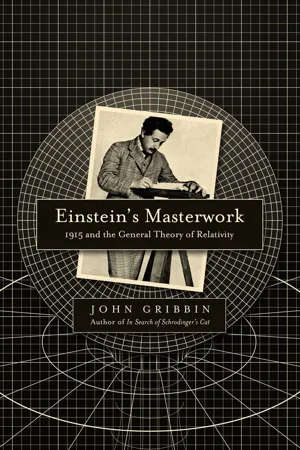
- 240 pages
- English
- ePUB (mobile friendly)
- Available on iOS & Android
Einstein's Masterwork
About this book
In 1915, Albert Einstein presented his masterwork to the Prussian Academy of Sciences, a theory of gravity, matter, space and time: the General Theory of Relativity. Einstein himself said it was "the most valuable theory of my life, " and "of incomparable beauty." It describes the evolution of the universe, black holes, the behavior of orbiting neutron stars, and why clocks run slower on the surface of the earth than in space. It even suggests the possibility of time travel.And yet when we think of Einstein's breakthrough year, we think instead of 1905, the year of Einstein's Special Theory of Relativity and his equation E=mc2, as his annus mirabilis, even though the Special Theory has a narrower focus.Today the General Theory is overshadowed by these achievements, regarded as "too difficult" for ordinary mortals to comprehend. In Einstein's Masterwork, John Gribbin puts Einstein's astonishing breakthrough in the context of his life and work, and makes it clear why his greatest year was indeed 1915 and his General Theory his true masterpiece.
Frequently asked questions
- Essential is ideal for learners and professionals who enjoy exploring a wide range of subjects. Access the Essential Library with 800,000+ trusted titles and best-sellers across business, personal growth, and the humanities. Includes unlimited reading time and Standard Read Aloud voice.
- Complete: Perfect for advanced learners and researchers needing full, unrestricted access. Unlock 1.4M+ books across hundreds of subjects, including academic and specialized titles. The Complete Plan also includes advanced features like Premium Read Aloud and Research Assistant.
Please note we cannot support devices running on iOS 13 and Android 7 or earlier. Learn more about using the app.
Information
Table of contents
- Cover
- Title
- Contents
- Introduction
- 1. In the Beginning
- 2. The Annus Mirabilis
- 3. The Long and Winding Road
- 4. Legacy
- 5. The Icon of Science
- Further Reading
- Endnotes
- List of Illustrations
- Illustrations
- Index
- About the Author
- Copyright